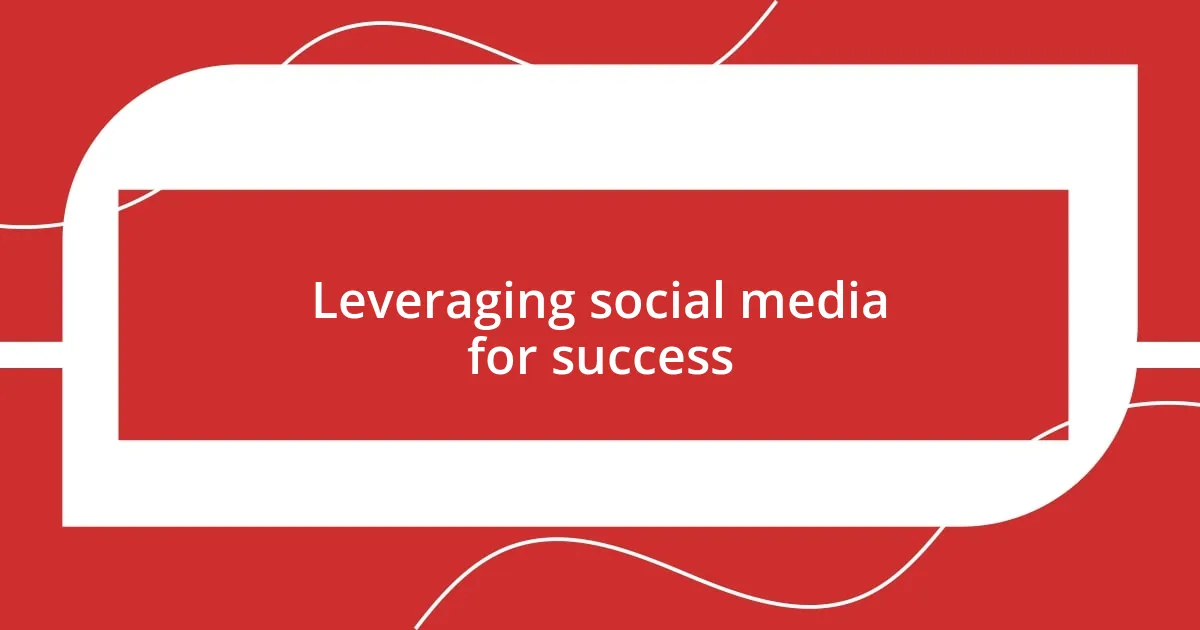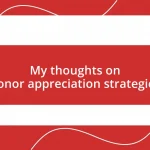Key takeaways:
- Peer-to-peer fundraising harnesses personal networks to create trust, deepen emotional connections, and transform donors into advocates for the cause.
- Effective storytelling, showcasing personal experiences and tangible impacts, is crucial for engaging supporters and driving donations.
- Choosing the right fundraising platform that offers user-friendliness, community support, and suitable features greatly influences campaign success.
- Success in fundraising extends beyond monetary figures; building connections, engaging communities, and fostering appreciation are central to impactful campaigns.

Understanding peer-to-peer fundraising
Peer-to-peer fundraising is essentially a strategy where individuals raise money on behalf of a nonprofit organization, often by tapping into their own personal networks. I remember when I first encountered this method; it struck me as an incredible way to blend community spirit with impactful fundraising. Just think about it: your friends and family believe in you, and they are likely to support a cause you’re passionate about, which can amplify your efforts significantly.
What’s fascinating to me is how this approach transforms donors into advocates. For instance, during a recent event I participated in, I witnessed firsthand how one person’s dedication inspired dozens of others to contribute. It really made me wonder—how powerful could our voices be when we unite them for a common goal? I believe this emotional connection not only drives donations but also fosters deeper relationships among supporters.
When you engage in peer-to-peer fundraising, the storytelling aspect is crucial. I’ve found that sharing genuine stories about the cause creates a compelling narrative that resonates more than just asking for money outright. The emotion behind each story not only draws people in but also encourages them to share their own experiences, turning a simple fundraising campaign into a rich dialogue of support and connection.

The benefits of peer-to-peer fundraising
Engaging in peer-to-peer fundraising offers a range of benefits to both organizations and individuals. From my experience, one key advantage is the power of personal connection. When each fundraiser reaches out to their network, it creates a sense of trust and authenticity that traditional fundraising methods often lack. I remember a time when I supported a friend’s campaign; the emotional impact of their personal story made me feel like I was truly part of something bigger than myself. It reinforced my commitment and made me excited to contribute.
Here are some of the standout benefits of peer-to-peer fundraising:
- Wider Reach: Each participant expands the organization’s reach into new communities.
- Increased Engagement: Fundraisers are typically more engaged and invested, which can lead to higher donation amounts.
- Cost-Effective: This method often requires fewer resources, maximizing donation impact.
- Community Building: It fosters camaraderie among supporters, strengthening social ties.
- Storytelling Opportunities: Fundraisers can share powerful narratives, enhancing emotional connections and driving more donations.
Each of these points illustrates the remarkable potential of peer-to-peer fundraising to create lasting relationships while simultaneously supporting vital causes. When I reflect on these experiences, I can’t help but see how each connection forms a wider web of support that can be both gratifying and transformative.

Choosing the right platform
Choosing the right platform for peer-to-peer fundraising can significantly impact your campaign’s success. From my own experiences, I’ve explored several platforms, each offering unique features. For instance, one of my early campaigns utilized a platform that provided robust analytics, which helped me understand donor trends better. It was eye-opening to see how data could guide my outreach strategy.
Platforms also vary in fee structures and user-friendliness. I remember the frustration of navigating a complicated interface while trying to customize my fundraising page. It made me realize that ease of use is just as important as any advanced feature. Would you want to waste time figuring out the platform when you could be connecting with supporters? Absolutely not! Therefore, I always recommend testing the platform’s usability before committing.
Lastly, consider the community and support each platform offers. I once chose a platform based solely on its popularity but found myself lacking in support when I needed it most. Connecting with a responsive team can make a world of difference, especially when issues arise. Ultimately, I believe that finding a platform that aligns with your goals, provides the necessary tools, and supports you through the journey is key to a successful campaign.
| Platform | Key Features |
|---|---|
| GoFundMe | User-friendly, no platform fees, community support |
| Classy | Robust analytics, customization options, fundraising tools |
| Fundly | Social media integration, mobile-friendly, low transaction fees |

Creating a compelling fundraising story
Creating a compelling fundraising story is essential for capturing attention and motivating supporters. When I crafted my own fundraising narratives, I focused on authenticity and vulnerability. For example, sharing a personal challenge I faced not only made my story relatable but also stirred a deeper emotional response from potential donors. Why would someone want to contribute if they can’t connect with the cause on a personal level?
As I delved deeper into storytelling techniques, I realized the importance of highlighting the impact of donations. In one campaign, I detailed how every dollar would translate into tangible results—like providing meals for families in need. This made it easy for donors to visualize their contribution’s effect. When I shared visual stories, like photos of families benefiting from the campaign, it created a powerful emotional hook that resonated with my audience, making them feel directly involved in the change.
Moreover, I learned that storytelling doesn’t have to be solely about the past; it can also paint a hopeful future. By sharing what success would look like—like a vibrant community thriving due to our collective efforts—I kept my audience engaged and eager to join. Have you ever felt that rush of excitement when being part of something transformational? That feeling is what I aimed to evoke in my supporters, and I can genuinely say, it brought my campaigns to life.

Leveraging social media for success
Social media is a powerhouse for peer-to-peer fundraising, and I quickly learned its importance in building my campaigns. When I started sharing my fundraising goals on platforms like Facebook and Instagram, the immediate engagement was thrilling. It felt like inviting friends to a party, and seeing their reactions motivated me to post updates regularly. Every like and comment was recognition of my efforts, reminding me how intertwined social connections and fundraising can be.
One memorable moment occurred when I created a short video sharing my journey and the impact of donations. To my surprise, it went viral among my friends’ networks. This experience reaffirmed my belief that storytelling amplifies engagement. I often ask myself, what can I share that resonates? The answers came in the form of behind-the-scenes glimpses, impromptu live sessions, and heartfelt messages that made supporters feel part of the journey. These moments turned supporters into advocates, leading to increased donations from unexpected quarters.
Additionally, leveraging social media provided me with valuable feedback. On one occasion, I ran a poll to understand which fundraising events my followers were most excited about. The results shocked me; a simple question opened up a dialogue that fostered community involvement. It not only tailored my approach but also made my supporters feel valued, complicating the distinction between donor and friend. Do I connect more deeply with my audience by involving them in decisions? Absolutely. Embracing social media in this way has been a game-changer, transforming my fundraising campaigns into collaborative endeavors.

Engaging and motivating your network
Engaging my network was a journey in itself, requiring me to tap into my relationships authentically. I remember one evening, sitting with a close friend who had supported my efforts in the past. We were talking about our shared passion for the cause I was fundraising for. Suddenly, I realized how powerful it was to invite others into the conversation about why this issue mattered to me. This personal touch not only sparked my friend’s enthusiasm but also encouraged them to share my story with their own circle. It made me wonder: how many connections could I foster just by being open about my mission?
As I implemented these conversations, I also discovered the magic of setting communal goals. During one campaign, I created a challenge for my supporters to collectively raise a certain amount by a specific date. I can’t quite describe the electric excitement that filled my inbox as friends sent messages filled with enthusiasm and creative ideas for how they’d contribute. Isn’t it incredible how a little friendly competition can ignite passion and community spirit? I’ve found that when people feel part of something larger than themselves, motivation increases exponentially.
A critical shift in my approach was recognizing the importance of appreciation. I started sending personal thank-you notes—not just after fundraising milestones, but along the way. One time, I surprised a supporter with a small gift as a token of gratitude for their contributions. The joy in their response made me realize how this extra effort turned simple supporters into lifelong advocates. It reminds me that every individual matter; how do we make everyone feel seen and appreciated? This mindset truly transformed my fundraising efforts into a collective celebration of shared purpose.

Measuring success and future planning
Measuring success in peer-to-peer fundraising has evolved significantly for me. Initially, I thought it was all about the monetary figures, but I soon realized that the real victory lies in the connections formed along the way. After one successful campaign, I reviewed not just how much was raised but how many conversations I had sparked and how many people shared their own experiences related to the cause. It made me wonder: what if each conversation could lead to a new advocate for future campaigns?
I’ve learned to track metrics beyond the basics—like engagement rates on social media and the number of personal connections I made with my donors. Reflecting on these qualitative aspects reinforces my passion for the cause. I can still recall the moment I received a heartfelt message from a supporter expressing how my initiative inspired them to start their own fundraising efforts. That one interaction felt like a ripple effect, igniting a network of commitment that goes beyond dollars and cents.
Looking ahead, I see the value in adapting my strategies based on these insights. I plan to implement more community-focused events, where the goal is not just fundraising but fostering a deeper understanding of the cause. How can we create an environment where supporters feel invested in the journey, not just the destination? I’m eager to explore that. The success of my future campaigns lies in realizing that every supporter is a potential champion, and together, we can cultivate a lasting impact.















